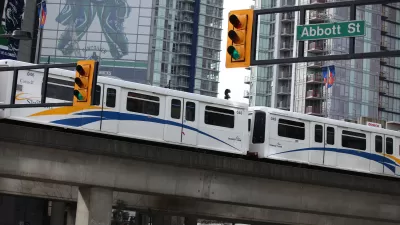North America
Why NYC's Most Exciting Architecture Can be Found Hanging on Walls
Planning a trip to NYC over the holidays? In a recent editorial, William Menking argues that “for visitors to New York, the place to look for the most exciting architectural ideas is not the city streets, but the walls of galleries and museums.”
A High Line for the Upper East Side?
Matt Chaban reports on the making of “the Upper East Side’s very own High Line." Current proposals seek not only to "re-pedestrianize" Park Avenue, but also to restore some of its turn of the century glory.
Teaching Architects to Succeed While Serving the Public Interest
The Public Interest Design Institute encourages architects to embrace participatory approaches in design that address complex social needs; demonstrating that it's possible to "make a career as an architect serving those who need the most help."
Why Cities Should Think Twice Before Rolling the Dice on Gambling
Seen as a source of economic development and easy money for cities (struggling or not) throughout North America, casino projects are neither a revenue panacea nor the win-win "economic bullet" that supporters claim, argues Richard Florida.
Is the Arctic Poised to Become the Next Silk Road?
Philip Bump contemplates a future in which Arctic Ocean trade routes give rise to thriving port cities dotting the northern coasts of North America and Eurasia alike.
The Steps to Creating a Meaningful Vision
In the three steps of placemaking, crafting a meaningful vision is the first and most straightforward, yet it's the most under-leveraged. Continuing his series on "Municipal Placemaking Mistakes," Nathan Norris describes how to get it right.
With a Little Help From Their Dutch Friends, Could New York Become New Amsterdam?
“In recent days, the Netherlands’ peerless expertise and centuries of experience in battling water have been widely hailed in the United States as offering lessons" for New York and for other cities alike, writes Andrew Higgins.

Sparking Creativity in Walkable Places
Happiness and health are generated or depleted by the way our neighbourhoods, towns, cities, and rural landscapes are developed. Creative placemaking adds to walkable urbanism by sealing the deal on physical, mental, and social well-being.

Is a Car More Environmentally Friendly Than Mass Transit?
Angie Schmitt takes issue with the controversial premise of a recent story from the popular Freakonomics guys. True to their reputation for counter-intuition, their most recent report makes the claim that "driving is greener than transit."
Happy Place of the Olden Days
Scott Bernstein joins in the Happiness Index conversation, starting with references to the Anatomy of Melancholy.

Should We Slow Down Our Pursuit of Rapid Transit?
Jarrett Walker examines the desirability of slow transit as argued by University of British Columbia Professor Patrick M. Condon in support of a vast streetcar network for Vancouver.

Is Your City an Innovator or a Follower?
Howard Blackson walks through the planning layers of San Diego for a history lesson as well as a look to the Next Urbanism.
Tackling Climate Change Through Density
Increasing mileage standards will do little to measurably reduce greenhouse gas emissions. In order to seriously tackle climate change we need to ditch the cars, and the development patterns they encourage, and move to walkable places.
What Can Sandy Learn from Katrina about Housing?
As the Sandy clean-up gets underway, could this be an opportunity for the Eastern Seaboard to apply some of the rebuilding lessons learned along the Gulf Coast after Katrina? Ben Brown shares some pointers.
Taking the 'Urban' out of Planning
What do we lose when we narrowly associate planning with an 'urban' or 'city' context? The ability to effectively plan for rural, transitional, regional, and even urban areas, says Ruth Miller.
NPR Distinguishes Energy Independence From Security
Surging oil and natural gas production has transformed the domestic energy paradigm. With the U.S. on track to replace Saudi Arabia as the world's largest oil producer, will the U.S finally meet President Nixon's 1973 goal of 'energy independence'?
Selling Change: Two Keys to a Successful Pilot Project
For communities or leaders reticent to buy into bold change, "selling change by the slice" through pilot projects can be a great way to get stakeholders on board with a larger vision. Otis White discusses two key components of pilot project success.
Toronto's Skyline Has High Ambitions Despite Housing Bubble Concerns
By a ratio of two-to-one, Toronto is far outpacing NYC in terms of high-rises and skyscrapers currently under construction. As other Canadian cities follow suit, Jim Flaherty, Canada's Finance Minister, is taking measures to cool the market.
Mastering an Incremental Approach to Development
For Howard Blackson, the latest trend in planning and design is redevelopment based on evolving, rather than phased, implementation. In this blog post he identifies the three typologies of this "slow urbanism."
Friday Funny: Superman's War on the Car
Dillon Fenner looks at early Superman comics and finds him to be not only less-than heroic, but a planner's nightmare: wiping out slums because he assumes the government will rebuild them, and declaring war on the car [language warning].
Urban Design for Planners 1: Software Tools
This six-course series explores essential urban design concepts using open source software and equips planners with the tools they need to participate fully in the urban design process.
Planning for Universal Design
Learn the tools for implementing Universal Design in planning regulations.
Heyer Gruel & Associates PA
JM Goldson LLC
Custer County Colorado
City of Camden Redevelopment Agency
City of Astoria
Transportation Research & Education Center (TREC) at Portland State University
Jefferson Parish Government
Camden Redevelopment Agency
City of Claremont


































